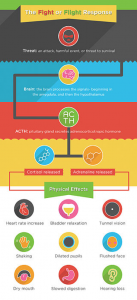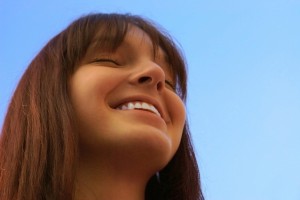Do you suffer from anxiety, depression, poor self-esteem or lack confidence?
What many of my clients don’t realise is the effect these conditions can have on their musculoskeletal system from tight muscles, headaches, difficulty breathing and poor posture.
Our Osteopath Emma Kopcikas will explain to us the impact mental health conditions have on the musculoskeletal system and how Osteopathy can help, as well as simple techniques we can incorporate into our day to lessen our anxiety and boost confidence.
Each year approximately 1 in 5 Australians are diagnosed with a mental illness, with only 35% using a health service for help (1). According to the Bureau of Statistics anxiety disorders are the most common mental illness affecting more females than males (2). So what is anxiety and how does it affect our musculoskeletal system?
What is Anxiety?
Feeling anxious, stressed or worried is a common responses to a situation when we feel under pressure such as public speaking, a job interview or going on a date. These emotions are perfectly normal and can even keep us safe for example when climbing a ladder; we have a heightened level of awareness and are more careful with our movements. These feelings usually resolve after the stressful situation has passed (3).
But for those with anxiety disorders the feelings of anxiousness, worry and fear remain and start interfering with day to day life. Those affected live constantly switched on in the ‘Fight or Flight’ response.
‘Fight or Flight’ response 
In this state the body prepares to either fight the perceived threat or flight, in other words run away from the danger. Therefore the body’s main response is to divert all its attention to what will help us to fight or run from the situation. These include:
- Increasing blood supply to our muscles and away from our digestive system so we can focus on running or fighting rather than digesting our toasted sandwich we had for lunch
- Increasing our blood pressure, heart rate and respiratory rate to supply the muscles with extra nutrients to prepare to run or fight
- Heightening our senses such as vision so we can adequately see the perceived threat
- Increasing muscle tone so we have extra strength and speed to fight or run
So what does this mean for our musculoskeletal system?
Many of my patients don’t realise the impact mental illnesses such as anxiety disorders are having on their body until we link their symptoms to the ‘Fight or Flight’ response. Typical symptoms I see in anxiety affected patient include:
- Poor posture – hunching forward is a protective mechanism we use to defend ourselves from a potential threat causing symptoms such as headaches, chest tightness, back pain and so on.
- Muscular tightness – as I mentioned before, the ‘Fight or Flight’ response increases muscular tone in the body to prepare itself for a perceived threat therefore causing patients muscular soreness, tight aching muscle pain, tenderness and loss of motion etc
- Difficulty breathing – many patients with anxiety tend to breath very shallow into the upper part of their chest rather than a deep, full belly breath. This causes them to feel constricted and have difficulty getting a full breath leading to dizziness and increased use of the neck muscles to assist with breathing causing tightness in the neck, jaw pain and headaches.
- Digestive issues – with blood being diverted away during the ‘Fight or Flight’ response, digestion slows to a near stop causing issues such as constipation, cramping and nausea and a decrease in appetite
- Exhaustion – with the nervous system constantly in a state of heighten sensitively it can leave a patient feeling drained by the constant signals telling the body to prepare to fight or run. It is also difficult for those with anxiety disorders to get a restful night’s sleep also
Image sourced from https://commons.wikimedia.org/w/index.php?curid=31481946By Jvnkfood – Own work.
How can Osteopathy Help?
Osteopathy works in combination to other mental health services to help to reduce anxiety and its impact on the body. Treatment will typically involve addressing the body’s overactive nervous system and the secondary flow on affects such as tight muscles, headaches, digestive issues and so on. You will also be given techniques you can include in your day to day life to reduce anxiety such as breathing exercises and postural advice.
Exercises to lower your anxiety before your first appointment
The 4, 7, 8 method
This exercise helps to turn down the effects of the nervous system if you are feeling anxious or stressed. It can be done whenever necessary and helps some people to fall asleep.
Firstly breathe in for a count of 4. You can count to 4 quickly or slowly but remember you need to maintain this rhythm throughout the exercise so pick a speed that you are comfortable with.
Next, hold your breath for a count of 7.
And finally, breathe out for a count of 8.
Another useful exercise is the Superhero pose. As many people probably know, when we free threatened, anxious or fearful we tend to make ourselves smaller by hunching forward and drawing our shoulders inwards and to the front. So therefore it is obvious to become more confident and less anxious we do the opposite. Studies such as the one published in the Physiological Science found that those who stood in a powerful pose for 2 minutes had a decrease of 25% in the stress hormone cortisol and an increase in the confidence boosting hormone testosterone (4). Whereas the opposite was true for those who posed in a low power position. It is though that by increasing the space your body occupies you become more powerful, confident and assertive and others view you in this manner as well.
To start, imagine Wonder Woman or Superman. The positions they strike are the ones we are aiming to achieve.
Firstly stand with the legs wide, shoulders back and chest open. Gentle tuck your chin towards your neck so that it is not stretched outwards but not being pulled back forcefully either. Then place your hands on your hips.
Hold this position for 2 minutes every morning and repeat during the day if necessary such as for a job interview or presentation.
Dr Emma Kopcikas, is an Osteopath at Vibe Natural Health Grange in North Brisbane. She practices Monday to Saturday and you can read more about Emma here.
To book please call our friendly reception team on 07 3366 7970 or online anytime
1. http://www.mindframe-media.info/for-media/reporting-mental-illness/facts-and-stats
2. Australian Bureau of Statistics. (2007). National Survey of Mental Health and Well-being: Summary of results. Catalogue No. 4326.0. Canberra, ACT: Australian Bureau of Statistics.
3. https://www.beyondblue.org.au/the-facts/anxiety
4. Carney, D. R., A. J. C. Cuddy, and A. J. Yap. “Power Posing: Brief Nonverbal Displays Affect Neuroendocrine Levels And Risk Tolerance”. Psychological Science 21.10 (2010): 1363-1368.

